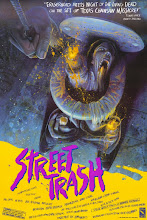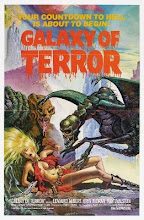Not only is it a considerably more satisfying Western than Django Unchained, The Hateful Eight is undeniable top-tier Tarantino, right up there with the Kill Bill movies and Inglourious Basterds*. I don't dislike Django, but for my tastes the odds are heavily stacked in The Hateful Eight's favour. I'm a sucker for tense, confined chamber pieces with strong ensemble casts, but my real bias towards QT's latest is that I'm an inveterate fan of John Carpenter's The Thing.
Going in, I was fully aware that Tarantino had infused his new film with the spirit of the sci-fi horror classic. He's gone on record as saying “The Thing is the one movie that is the most influential on this movie". I was expecting the obvious superficial connections: Kurt Russell in a lead role; an Ennio Morricone score; an almost entirely male ensemble trapped in a confined space during a blizzard. What I wasn't prepared for is the revelation that The Hateful Eight hews so closely and faithfully to Carpenter's film, that for all intents and purposes it has to be considered a spiritual remake. I say "spiritual" because of course there's no DNA assimilating alien monster here. However, make no mistake, in every other sense this is a far more effective remake of the 1982 film than the dismal prequel that came out five years ago.
"Somebody in this camp ain't what he appears to be"
- Kurt Russell, The Thing
"One of them fellas is not what he says he is"
- Kurt Russell, The Hateful Eight
Those echoing lines, deliberately calculated to jog the viewer's memory, are just the tip of the iceberg. For starters, passages are lifted wholesale from Morricone's score for The Thing, most noticeably "Despair" (as well as some unused material that can be found on The Thing's OST). Entire scenes and sequences from the '82 film are blatantly referenced, if not straight up copied. The blood testing sequence is reinterpreted as a scene in which Samuel Jackson's Major Marquis Warren holds the surviving lodgers of Minnie's Haberdashery at gunpoint. Also faithfully recreated are the tense exchanges between characters, as they test the true nature of each other's identities and attempt to form fragile alliances. Several instances of characters struggling off into the blizzard, their isolation from the group making them instant red herrings, are also the most obvious visual references. The final exchange, in the aftermath of the violence, between an exhausted MacReady and Childs is also cribbed. It's all there.
Just to leave you in absolutely no doubt that what you're watching is actually nihilistic horror in the guise of a Western, Tarantino throws in a cue from Last House on the Left - David Hess' "Now You're All Alone". Further confirmation of that comes in the form of exploding heads, vomited innards and splattering squibs. This is far and away Tarantino's goriest film since Kill Bill.
Watching The Hateful Eight was a blast for me. On top of the usual qualities that you expect from one of Tarantino's best - great dialogue, characters, score, visuals and action - this was the closest I've ever gotten to reliving the thrill of seeing Carpenter's masterpiece for the first time thirty-four years ago. Countless filmmakers have tried to emulate The Thing by one-upping Rob Bottin's fx (a lost cause from the get go), but Tarantino wisely approaches the material from the human angle, which is plenty alienating enough. As with The Thing, the result is riveting - a tangled web of paranoia, hidden identities and shifting allegiances that keeps you guessing until the final scene.
I couldn't be happier with the new breed of high quality, ultra violent Western that we're seeing (and I'm including the lesser, but still very enjoyable The Revenant). It's like an exploitation fan's dream come true to have a pair of Kurt Russell starring oaters that are as indebted to Deodato and Carpenter as they are to Corbucci, Peckinpah and Leone. Next up, following his strongest film to date (The Sacrament), I have high hopes for Ti West's In a Valley of Violence.
*I'm aware that this is a very subjective statement, and I admit that my appreciation of Tarantino's movies is largely driven by my preference for certain genres over others. Reservoir Dogs and Pulp Fiction are objectively better movies than Death Proof any day of the week, but I'm more likely to want to revisit a violent horror/exploitation hybrid (starring Kurt Russell) than a straight up crime film.























































































































































